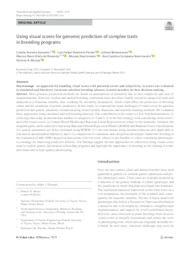Using visual scores for genomic prediction of complex traits in breeding programs.
Using visual scores for genomic prediction of complex traits in breeding programs.
Author(s): AZEVEDO, C. F.; FERRÃO, L. F. V.; BENEVENUTO, J.; RESENDE, M. D. V. de; NASCIMENTO, M.; NASCIMENTO, A. C. C.; MUNOZ, P. R.
Summary: An approach for handling visual scores with potential errors and subjectivity in scores was evaluated in simulated and blueberry recurrent selection breeding schemes to assist breeders in their decision-making. Most genomic prediction methods are based on assumptions of normality due to their simplicity and ease of implementation. However, in plant and animal breeding, continuous traits are often visually scored as categorical traits and analyzed as a Gaussian variable, thus violating the normality assumption, which could affect the prediction of breeding values and the estimation of genetic parameters. In this study, we examined the main challenges of visual scores for genomic prediction and genetic parameter estimation using mixed models, Bayesian, and machine learning methods. We evaluated these approaches using simulated and real breeding data sets. Our contribution in this study is a five-fold demonstration: (i) collecting data using an intermediate number of categories (1-3 and 1-5) is the best strategy, even considering errors associated with visual scores; (ii) Linear Mixed Models and Bayesian Linear Regression are robust to the normality violation, but marginal gains can be achieved when using Bayesian Ordinal Regression Models (BORM) and Random Forest Classification; (iii) genetic parameters are better estimated using BORM; (iv) our conclusions using simulated data are also applicable to real data in autotetraploid blueberry; and (v) a comparison of continuous and categorical phenotypes found that investing in the evaluation of 600-1000 categorical data points with low error, when it is not feasible to collect continuous phenotypes, is a strategy for improving predictive abilities. Our findings suggest the best approaches for effectively using visual scores traits to explore genetic information in breeding programs and highlight the importance of investing in the training of evaluator teams and in high-quality phenotyping.
Publication year: 2024
Types of publication: Journal article
Unit: Embrapa Coffee
Observation
Some of Embrapa's publications are published as ePub files. To read them, use or download one of the following free software options to your computer or mobile device. Android: Google Play Books; IOS: iBooks; Windows and Linux: Calibre.
Access other publications
Access the Agricultural Research Database (BDPA) to consult Embrapa's full library collection and records.
Visit Embrapa Bookstore to purchase books and other publications sold by Embrapa.

